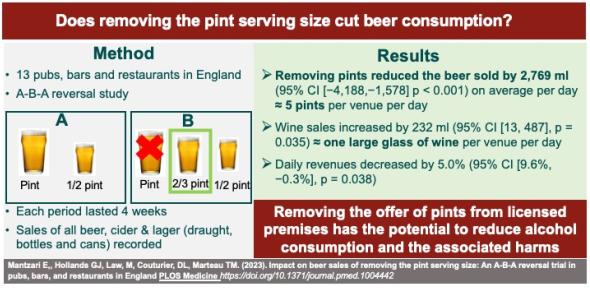
Submitted by A.S. Quenault on Wed, 18/09/2024 - 09:28
Researchers from the Behaviour and Health Research Unit at the University of Cambridge and the MRC Biostatistics Unit (BSU) have been studying links between alcohol consumption and serving sizes. They previously found that when pubs, bars and restaurants removed their largest serving of wine by the glass - usually 250ml - sales of wine decreased by 7.6%. But is the same true for beer and cider?
In a newly published study in PLOS Medicine, 13 licensed premises in England removed pint serving sizes for beer and cider for 4 weeks. The study took place over three consecutive 4-week periods. During the first and last periods, venues offered their standard serving sizes which included pints. During the second period, venues removed the offer of pints for all draught beer and cider, so that the largest available serving sizes became two-thirds of a pint. During all study periods, we measured the sales of all beers and ciders.
The researchers found that removing the pint serving size reduced sales of beer and cider by around 10%, equivalent to about 5 pints per venue per day. Wine sales increased slightly – on average by about one large glass of wine per venue per day, which is much too small to offset the reduced sales of alcohol from removing pints.
Daily revenues also decreased by about 5%.
These new findings suggest that removing the offer of pints from licensed premises has the potential to reduce alcohol consumption and the associated harms
Professor Theresa Marteau, Director of the Behaviour and Health Research Unit said:
Alcohol brings pleasure but also pain, increasing the risk 7 types of facers including bowel, breast and liver cancers. This study showed that replacing the largest serving size of beer – the pint – with a two-thirds pint in pubs, bars and restaurants, is a promising intervention for decreasing alcohol consumption to improve population health.
Dr Dominique-Laurent Couturier, Senior Research Associate at the BSU, and Dr Martin Law, Research Associate at the BSU, both carried out crucial statistical analysis on this study and said:
This study provides evidence that offering two-thirds pint serving sizes instead of the usual pints nudges pub patrons into reducing the amount of beer consumed, a significant finding given the negative health effects related to drinking.
Beyond its potential impact, what made this research project appealing to us, statisticians, is the high standard for reproducibility of typical studies by Marteau et al.: carefully designed studies involving statistical experts early on; sample size defined by considering effect sizes drawn from previous evidence; use of pre-registered protocols for data collection, analysis and sensitivity analyses; data and code ultimately shared with the community. An exemplary 'modus operandi' that should be adopted more widely.
To read the findings of the study in full, click here http://journals.plos.org/plosmedicine/article?id=10.1371/journal.pmed.1004442

